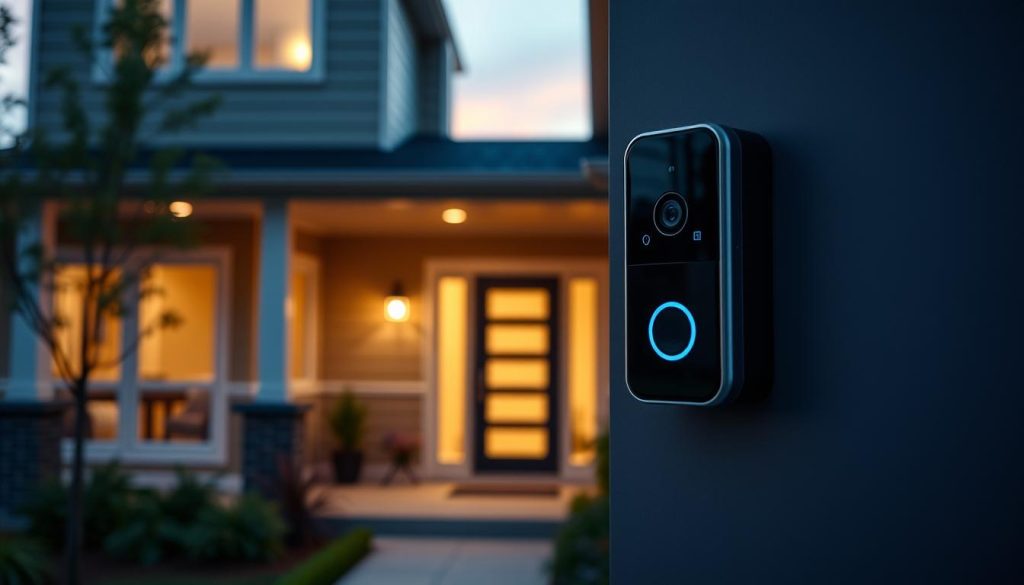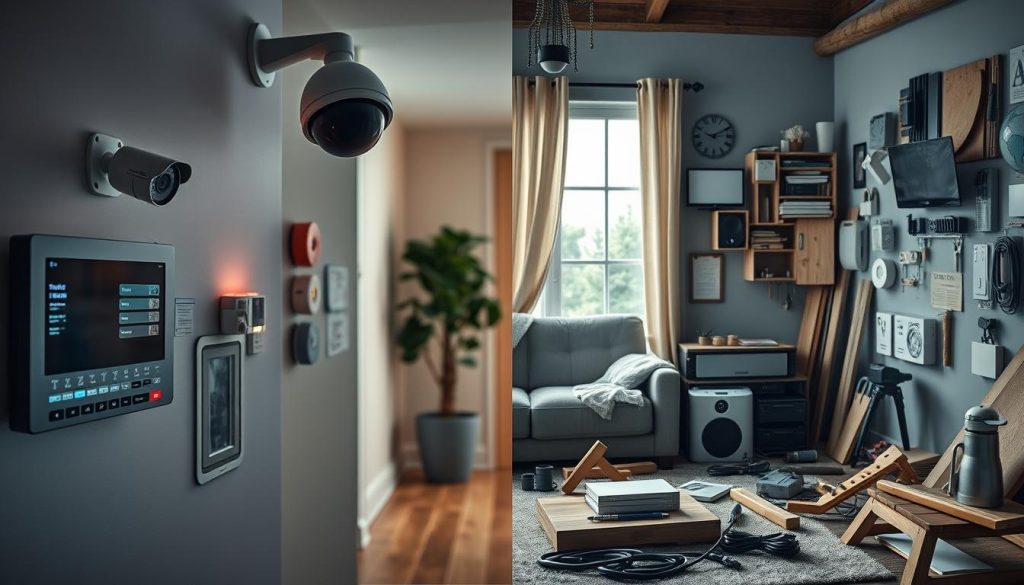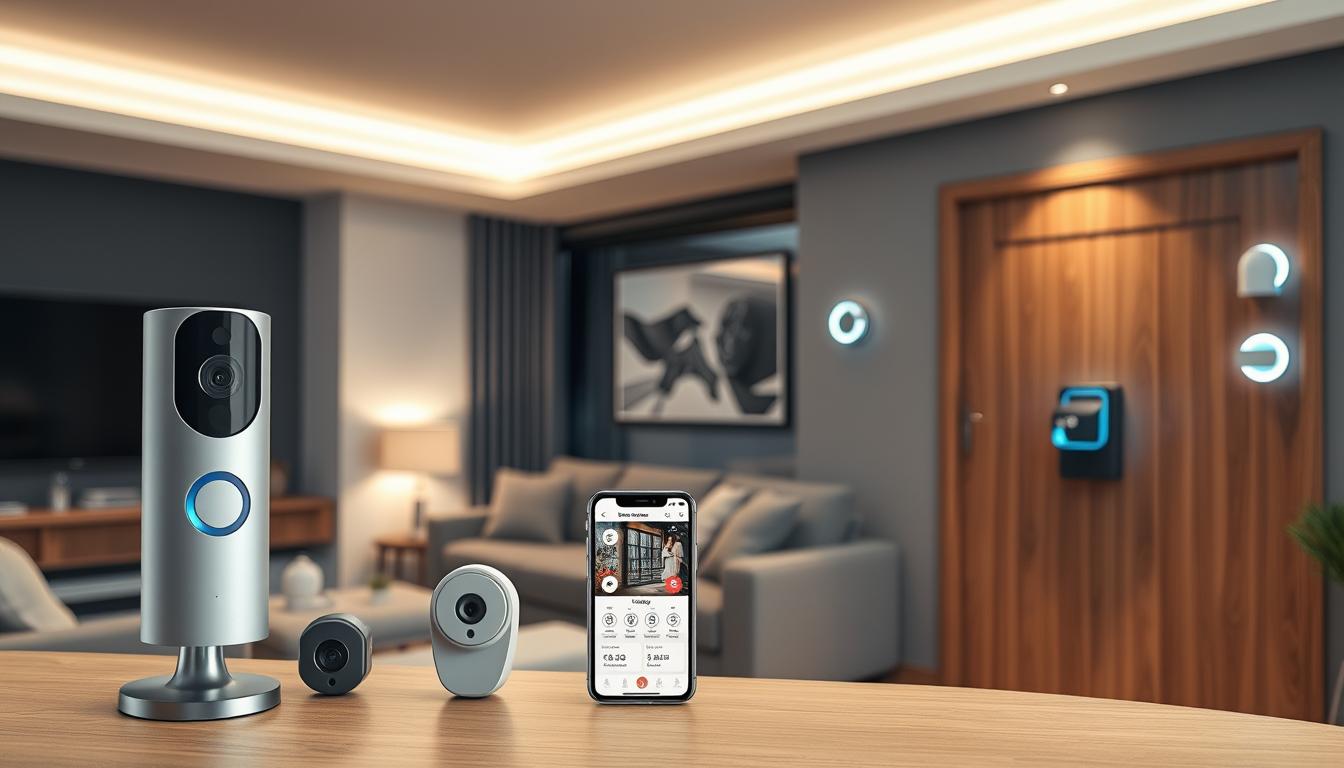Your home’s security is more important than ever in today’s world. Technology has changed home security, offering many new gadgets. These include AI cameras and biometric locks, making your home safer.
This article will show you the top 5 tech gadgets for home security. They help you control your safety and give you peace of mind. Whether you’re updating or starting fresh, these devices will boost your home’s security and fit well with your smart home.
Key Takeaways
- Discover the latest cutting-edge home security gadgets that offer advanced protection
- Explore how smart security cameras, video doorbells, and smart locks enhance your home’s defenses
- Learn about the benefits of integrating home security devices with your smart home ecosystem
- Understand the importance of motion detection systems and sensors in comprehensive home security
- Evaluate the pros and cons of professional vs. DIY security systems to find the right fit for your needs
Understanding Modern Home Security Solutions
Home security has changed a lot, moving from old locks to smart security systems. These systems use connected security devices to give homeowners great protection and ease. They also work well with smart home ecosystems.
At the center of modern security are smart security systems. They combine cameras, sensors, and smart locks. These systems work with Amazon Alexa and Google Home, letting you control them with your voice.
Evolution of Smart Security Systems
The change in smart security systems has changed how we protect our homes. Big systems with many connected security devices can cost a lot, up to $1,000. They are easy to set up yourself and work with apps for remote control.
Benefits of Connected Security Devices
Connected security devices offer many benefits. They send alerts in real-time, let you access your home from anywhere, and work well with other smart home tech. Many systems also have cloud storage and professional monitoring for less money than old security services. They can scare off burglars, help in emergencies, and give you peace of mind.
Integration with Smart Home Ecosystems
Connecting smart security systems with smart home ecosystems has changed home automation. Smart speakers like Amazon Echo and Google Nest let you control your home with your voice. This makes your home safer and more convenient.
As smart security systems get better, we’ll see new features. Expect better encryption, more protection against hackers, and stronger privacy. The future of home security looks bright, with AI, cloud storage, and new tech making our homes safer.
Smart Security Cameras: Your First Line of Defense
Smart security cameras are key to home safety. They come with AI and many features to protect your home and family. They offer constant monitoring, motion detection, and night vision, making them top-notch protectors.
The Frontpoint system has a motion sensor that spots movement up to 40 feet away. Its indoor camera sees in the dark and covers up to 15 feet. Outdoor cameras work all day, every day, no matter the weather.
These cameras work with the Frontpoint Hub & Keypad, your home’s security center. They send alerts and alarms when they see something wrong. The Smoke + Heat Sensor also watches for fires, offering help when needed.
The Home Defense Kit warns off intruders with stickers and signs. It has two ways to connect, keeping your system online and secure.
These cameras let you watch your home from anywhere with the Frontpoint app. You can see what’s happening and get alerts, so you can relax.
Smart security cameras are vital for home safety today. They use AI and connect with smart homes to keep your place safe all the time.
Video Doorbell Systems: Remote Monitoring Made Easy
Video doorbells like the Ezviz DB1C Wi-Fi make it easy to watch your home’s entrance from anywhere. They offer clear HD video, wide views, and two-way audio. This lets you see, hear, and talk to visitors remotely.
These devices store video locally or in the cloud. They work with Amazon Alexa, Google Assistant, and IFTTT for easy automation.
Features to Look for in Video Doorbells
When picking a video doorbell, look for motion detection, night vision, and instant alerts. AI in these devices can spot packages, pets, and even people you know. This means you get more accurate alerts about what’s happening at your door.
Installation and Connectivity Options
Video doorbells come wired or wireless, fitting different needs. Wired ones work with your chime system, while wireless ones need battery recharging but are more flexible. A strong Wi-Fi connection is key for smooth monitoring.
Popular Video Doorbell Brands
Top brands include Ring, Nest, and Arlo. They offer various features, connections, and prices. This helps homeowners find the right security solution. But, some brands like Wyze have security issues and weren’t reviewed for privacy reasons.

Video doorbells are a key part of smart home security. They offer remote monitoring, advanced features, and easy integration with other devices. By choosing wisely, you can protect your home effectively.
| Brand | Video Resolution | Free Cloud Storage | Subscription Options |
|---|---|---|---|
| Google Nest Doorbell | 960×1280 | 3 hours | $8/month or $80/year for 30 days; $15/month or $150/year for 24/7 recording |
| Ring Doorbell | 1080p | No free storage | $3/month or $30/year for 60 days of video history |
| Arlo Video Doorbell | 1536×1536 | 7 days | $3/month or $30/year for 30 days of video history |
“Video doorbells are a game-changer in home security, providing remote monitoring and advanced features that enhance the protection of our homes.”
Advanced Smart Lock Technology
Smart locks have changed home security, giving homeowners more control and ease. Smart locks like the Ultraloq U-Bolt Pro Wi-Fi offer many ways to enter your home, like fingerprints, voice commands, mobile apps, and keys. These devices not only make your home safer but also let you check and manage access from anywhere.
The newest smart locks work well with smart homes, letting you manage access and see who’s coming and going from one place. They have cool features like auto-locking, temporary codes for visitors, and logs of who’s been in and out. Some, like the Yale Assure Lock 2 Touch, even have fingerprint readers for extra security.
The market has many smart lock choices. The Wyze Lock Bolt has a quick fingerprint reader, a keypad that lights up, and lasts up to a year on one battery, all for $79. The Yale Assure Lock 2 offers many ways to get in, including keys, keypads, fingerprints, apps, and voice control, making it a great choice for many.
| Smart Lock | Price | Battery Life | Access Options |
|---|---|---|---|
| Ultraloq U-Bolt Pro Wi-Fi | $149.00 | 6 months to 1 year | Fingerprint, voice, mobile app, keys |
| Yale Assure Lock 2 | $116 – $209.99 | 6 months to 1 year | Keys, keypad, fingerprint, app, voice |
| Wyze Lock Bolt | $79 | 1 year | Fingerprint, keypad |
As smart home tech gets better, smart locks with features like biometrics and easy connections are becoming more common
Motion Detection Systems and Sensors
Home security is greatly improved with motion detection systems. These systems use various sensors to spot movement and act accordingly. Knowing how these technologies work is key to better protecting your home.
Types of Motion Sensors
There are many types of motion sensors, each with its own strengths. Passive Infrared (PIR) sensors catch changes in infrared energy. Microwave sensors send out and catch radio wave disturbances. Ultrasonic sensors use sound waves to detect motion. Tomographic systems create a network to sense radio wave changes.
Today’s motion detectors often mix these technologies. This makes them more accurate and less likely to set off false alarms.
Placement Strategies for Maximum Coverage
Where you place motion sensors is very important. Most basic sensors can spot movement up to 4.6 meters (15 feet). Advanced systems can see through walls and obstacles.
Place sensors at least 10 feet from windows and heating vents to avoid false alarms. Adjust their sensitivity to find the right balance.
Smart Integration Capabilities
Motion sensors work well with other smart home devices. When they detect motion, they can start cameras, set off alarms, and even change lights to scare off intruders. You can get alerts on your phone, letting you check on your home from anywhere.
This integration makes your security system more effective. It gives you peace of mind knowing your home is well-protected.
Using advanced motion detection and placing sensors wisely can make your home very secure. Adding these sensors to your smart home devices makes your protection even stronger. This gives you the confidence you need.
| Motion Sensor Technology | Key Benefits | Potential Drawbacks |
|---|---|---|
| Passive Infrared (PIR) | – Detects changes in infrared energy – Commonly used in security systems |
– Can be triggered by warm-blooded animals – Requires careful placement to avoid false alarms |
| Microwave | – Penetrates walls and obstacles – Can cover multiple rooms or areas |
– More prone to interference and false alarms |
| Ultrasonic | – Detects motion through audio frequency reflections – Can cover large areas with obstructions |
– Limited to line-of-sight detection |
| Tomographic | – Creates a mesh network for wide-area coverage – Can penetrate most walls and obstacles |
– Often a premium option due to higher costs |
| Dual-Technology | – Combines multiple sensor types for enhanced accuracy – Reduces false alarm potential |
– May compromise detection probabilities |
By knowing about different motion sensor technologies and how to use them, you can build a strong defense for your home.
Professional vs. DIY Security Systems
Homeowners can choose between professional monitored systems like ADT Command or DIY options like SimpliSafe. Professional systems offer full protection and expert monitoring but cost more. ADT’s professional setup starts around $150, while Vivint’s starts at $100.
DIY systems are cheaper, flexible, and don’t require long-term contracts. They can be up to three times less expensive than professional setups. SimpliSafe starts at $125 for DIY, and Abode at $100.
- Professional security systems offer comprehensive protection and expert monitoring, but at a higher cost.
- DIY security systems provide flexibility, cost-savings, and no long-term contracts, but may lack advanced features.
- Factors to consider when choosing between professional and DIY security include budget, technical expertise, and desired level of control.
Choosing a home security system involves weighing the pros and cons of both options. DIY systems save money but might not offer the same level of customer service and monitoring as professional systems. Your decision should depend on your budget, technical skills, and how much security and control you need.

“The flexibility and cost-effectiveness of DIY security systems make them an attractive option for many homeowners, but the comprehensive protection and expert monitoring of professional solutions can provide added peace of mind.”
Technology in Home Security: Present and Future
The world of home security is changing fast. This is thanks to new tech like artificial intelligence (AI), cloud-based systems, and other emerging solutions. These innovations are making our homes safer and more secure for our families.
Artificial Intelligence in Security Systems
AI is changing home security for the better. It brings features like facial recognition, behavior analysis, and predictive threat detection. These features are now part of modern security systems.
AI-powered systems send alerts in real-time and respond automatically. They also offer personalized security options. This makes our homes safer and more convenient.
Cloud Storage Solutions
Cloud-based storage is becoming key in home security. It’s great for storing and accessing video footage and security logs. This way, important data is safe and can be reached from anywhere.
Cloud storage is also good for protecting data, being easy to access, and saving money. It’s a smart choice for those looking for strong and future-proof security.
Emerging Security Technologies
New tech like drone surveillance, blockchain, and IoT devices is coming. These will make home security even better. They promise better monitoring, secure data, and easy smart home integration.
As these techs get better, our homes will be safer. We’ll feel more secure and protected.
AI, cloud security, and new tech are changing home security. They’re making it smarter, more connected, and more effective. The future looks bright for safer, more efficient homes and communities.
“The future of home security lies in the integration of advanced technologies, empowering homeowners to take control of their safety and embrace the seamless convergence of security and smart home capabilities.”
Cost Considerations and Budget Planning
Home security costs can vary a lot. This depends on the equipment, installation, and monitoring services you pick. Security system costs range from affordable DIY options to more expensive professional systems.
DIY systems, like SimpliSafe, are cheaper. They offer flexible monitoring plans that fit your budget. Professional systems from ADT, on the other hand, offer more features but cost more.
Thinking about a long-term security investment means looking at benefits like insurance discounts and higher home value. DIY systems or smart devices like cameras are good for tight budgets. Professional systems are a big investment in your home’s safety.
There are many budget-friendly security options out there. From simple cameras to full security packages. By looking at your needs and the long-term value, you can find a good fit for your budget.
| Security System Type | Average Cost | Key Benefits |
|---|---|---|
| DIY Security Systems | $200 – $500 |
|
| Professional Security Systems | $500 – $2,000+ |
|
“Investing in a comprehensive home security system can provide peace of mind and long-term value, even with a higher upfront cost. The key is to find a solution that fits your budget and security needs.”
The choice between DIY or professional systems depends on your budget and security needs. By looking at security system costs, budget-friendly security options, and long-term security investment, you can find a good fit for your home and budget.
Energy Efficiency and Power Management
As people want better home security, saving energy is key. Using LED bulbs can cut energy use by up to 80%. A company in the manufacturing sector cut its energy costs by 20% with a smart energy system.
Renewable sources like solar or wind power are great for energy needs. Smart energy systems help save money for homes and businesses by using energy wisely.
Solar-Powered Security Options
Solar-powered cameras are a green and easy way to watch over your outdoor space. A home in Germany became almost fully energy-independent with solar, heat pumps, and batteries. Smart meters and software helped many save on electricity and gas.
Worldwide, governments are offering help to make smart energy tech more common.
Battery Life and Backup Systems
Keeping your security system running smoothly is vital. Turning off power management can cost over $9,400 a year and use 76,000 kWh more. ENERGY STAR computers and monitors must have power management on to save energy and extend battery life.
Backup batteries and solar charging make systems more reliable and less prone to power issues.
New tech like Gallium Nitride (GaN) and Silicon Carbide (SiC) makes devices more energy-efficient. Techniques like Dynamic Voltage and Frequency Scaling (DVFS) and power gating help save power in modern electronics. Energy-saving displays and wireless tech make security solutions more eco-friendly.
“The future of home security lies in energy-efficient, sustainable solutions that prioritize both protection and environmental responsibility.”
By choosing solar, smart power management, and the latest tech, homeowners can get top-notch security without harming the planet or their wallets.
Security System Maintenance Tips
Keeping your security system in top shape is key to protecting your home or business. Regular care and attention can greatly improve your security devices’ performance and lifespan. Start by cleaning the lenses of your security cameras to enhance their recording quality. This simple step can boost their effectiveness by up to 20%.
Also, make sure to test your alarm systems often. This ensures they work right and can increase their effectiveness by 25%.
Don’t forget to replace the batteries in your wireless security devices. Over 80% of security failures are due to battery issues. Alkaline batteries last 3-5 years, while lithium-ion batteries last 6-12 months. Keeping up with these replacements can prevent system failures and false alarms.
It’s also vital to keep your security system’s software and firmware updated. This protects against vulnerabilities and brings you the latest features. Updating these can cut down security system risks by 40% and solve about 65% of potential problems. Professional maintenance can prevent up to 50% of security system issues. With regular self-care or a service plan, your security system will stay in great condition.



